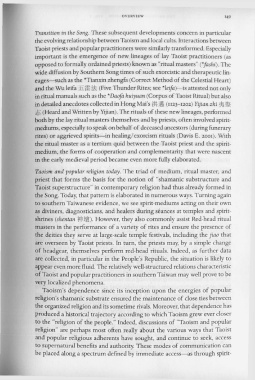Page 189 - The Encyclopedia of Taoism v1_A-L
P. 189
OVERVI EW 149
Transition in the Song. These subsequent developments concern in particular
the evolving relationship between Taoism and local cults. Interactions between
Taoist priests and popular practitioners were similarly transformed. Especially
important is the emergence of new lineages of lay Taoist practitioners (as
opposed to formally ordained priests) known as "ritual masters" (*fashi). The
wide diffusion by Southern Song times of such exorcistic and therapeutic lin-
eages-such as the *Tianxin zhengfa (Correct Method of the Celestial Heart)
and the Wu leifa Ji 'lli' 1t (Five Thunder Rites; see *leifa)-is attested not only
in ritual manuals such as the *Daofa huiyuan (Corpus of Taoist Ritual) but also
in detailed anecdotes collected in Hong Mai's #um (II23- 1202) Yijian zhi 3f~
,(!" (Heard and Written by Yijian). The rituals of these new lineages, performed
both by the lay ritual masters themselves and by priests, often involved spirit-
mediums, especially to speak on behalf of deceased ancestors (during funerary
rites) or aggrieved spirits-in healing/ exorcism rituals (Davis E. 2001) . With
the ritual master as a tertium quid between the Taoist priest and the spirit-
medium, the forms of cooperation and complementarity that were nascent
in the early medieval period became even more fully elaborated.
Taoism and popular religion today. The triad of medium, ritual master, and
priest that forms the basis for the notion of "shamanic substructure and
Taoist superstructure" in contemporary religion had thus already formed in
the Song. Today, that pattern is elaborated in numerous ways. Turning again
to southern Taiwanese evidence, we see spirit-mediums acting on their own
as diviners, diagnosticians, and healers during seances at temples and spirit-
shrines (shentan ;f$i:\!). However, they also commonly assist Red-head ritual
masters in the performance of a variety of rites and ensure the presence of
the deities they serve at large-scale temple festivals, including the jiao that
are overseen by Taoist priests. In turn, the priests may, by a simple change
of headgear, themselves perform red-head rituals. Indeed, as further data
are collected, in particular in the People's Republic, the situation is likely to
appear even more fluid. The relatively well-structured relations characteristic
of Taoist and popular practitioners in southern Taiwan may well prove to be
very localized phenomena.
Taoism's dependence since its inception upon the energies of popular
religion's shamanic substrate ensured the maintenance of close ties between
the organized religion and its sometime rivals. Moreover, that dependence has
produced a historical trajectory according to which Taoism grew ever closer
to the "religion of the people." Indeed, discussions of "Taoism and popular
religion" are perhaps most often really about the various ways that Taoist
and popular religious adherents have sought, and continue to seek, access
to supernatural benefits and authority. These modes of communication can
be placed along a spectrum defined by immediate access- as through spirit-

